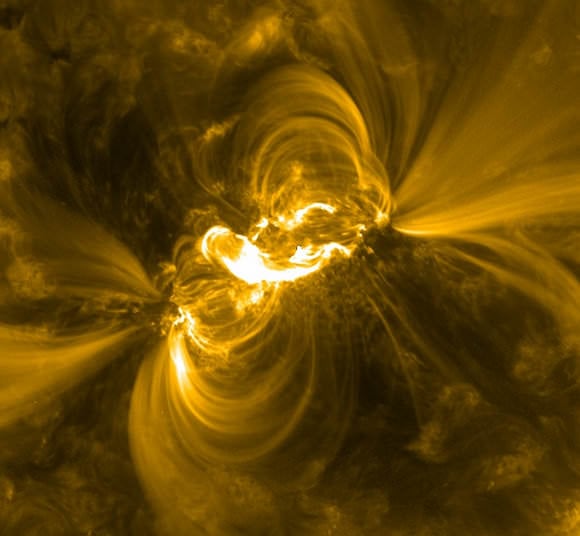[/caption]
On February 13, 2011, sunspot 1158 let loose the strongest solar flare of the current solar cycle, a blast of radiation across the electromagnetic spectrum, from radio waves to x-rays and gamma-rays. NASA's Solar Dynamics Observatory recorded an intense flash of extreme ultraviolet radiation, as seen above, and located in approximately the middle of the Sun's disk in the image below. The eruption also produced a loud blast of radio waves, and coronagraph data from STEREO-A and SOHO agree that the explosion produced a fast but not particularly bright coronal mass ejection.
Spaceweather.com
predicts a CME cloud will likely hit Earth's magnetic field on or about Feb. 15th, and high-latitude sky watchers should be alert for auroras.
[caption id="attachment_83287" align="aligncenter" width="580" caption="A M6.6-category flare on Feb. 13. Credit: NASA/SDO"]
[/caption]
This was an M6.6-category flare. Find out more about the classification of solar flares
at this link at Spaceweather.com
[caption id="attachment_83288" align="aligncenter" width="580" caption="Another view from SDO of the flare. Credit: NASA/SDO"]
[/caption]
[caption id="attachment_83289" align="aligncenter" width="580" caption="A look at sunspot 1158 as of Feb. 14, 2011. This is the source of the recent activity on the Sun. Credit: NASA/SDO"]
[/caption]
Jason Major from
Lights in the Dark
created the video below of magnetic activity around a sunspot 1158, from data region from SDO spacecraft, during February 12-13, 2011.
Keep tabs on the Sun by visiting the
SDO website, which shows the current Sun
in several different wavelengths.
Sources:
SDO,
Spaceweather.com
 Universe Today
Universe Today
